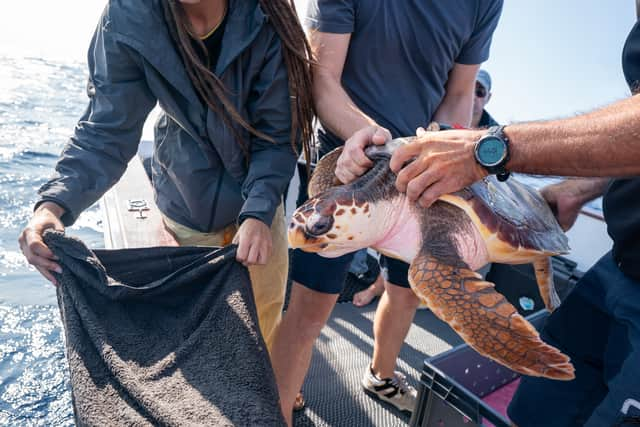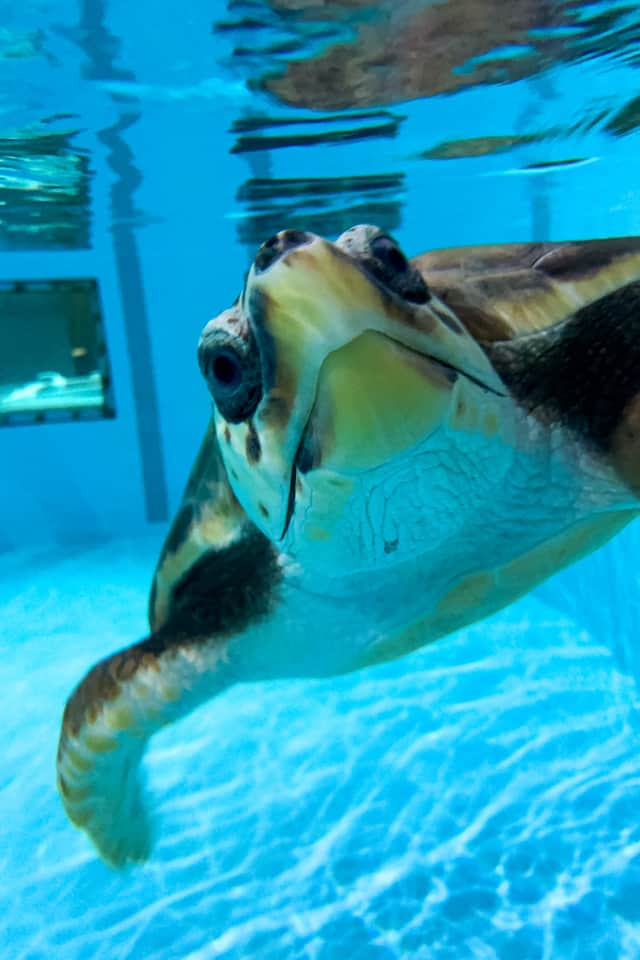Iona the turtle: 'malnourished and dehydrated' turtle returns to sea after two years with wildlife rehabbers
and live on Freeview channel 276
A “malnourished and dehydrated” turtle that washed up on a Scottish beach more than a thousand miles from her home has made a glorious return to the wild.
Iona - named for the Scottish island she was found on - was not expected to “make the night” after she was found in 10C water in January 2022. The loggerhead turtle , the smallest of her kind ever found alive in the UK, was cold-stunned and dehydrated when she was spotted by a passer-by.
Advertisement
Hide AdAdvertisement
Hide AdThe team at the British Divers Marine Life Rescue contacted Sea Life in Loch Lomond to bring her in for rehabilitation, and Iona was relocated to Sea Life in Scarborough in May last year for further care. Before making the 1,700 mile journey to the Azores in Portugal this month – her natural habitat.


Todd German, animal care curator at Sea Life Scarborough, told PA she was “lucky” to have been discovered. “She was found by a passer-by in the bleak midwinter, which is just incredibly lucky that she was found. [It] was really touch and go whether or not she would pull through and make it.”
Mr German said that her release back into the wild felt “surreal”. “It was really strange in the fact that that was the end of my part in her journey and it was a really lovely feeling to see her go off into the big blue.
“Sea turtles around the world are really facing challenges, and I dread to say, they’re human-faced challenges. That’s through climate change and also our interaction with the natural environment and turtles themselves," he continued. “We, as Sea Life, as aquariums, want to play our part in contributing back to the wild and hopefully giving the sea species and turtles the chance of survival for millions of years to come.”


Advertisement
Hide AdAdvertisement
Hide AdFor Robin Hunter, display supervisor at Sea Life Loch Lomond and part of Iona’s care team, it was his first time rehabilitating a turtle. “It was obviously not the best experience that you’d want for the turtle, but to be part of something like that is pretty spectacular. You really feel like you’re making a difference.
“To be able to see her now go and live the way she’s supposed to be living, that is a phenomenal feeling," he said. “There’s a small percentage of worry because you never know. It’s the wild at the end of the day, but she is a fighter.”
Mr Hunter said that Iona was not in good condition when she was first discovered. “When she first arrived, she wasn’t in great condition and she was very dehydrated, very malnourished…. we really didn’t expect her to make the night.
“Bit by bit, with a lot of work from the care team, we were able to slowly raise her temperature," he said. “It was remarkable. It was like a totally different turtle.”
Advertisement
Hide AdAdvertisement
Hide AdMr Hunter said it was “a very slow process” restoring Iona to a healthy weight. She gradually increased to 21kg - which is 10 times her weight when she was found. The loggerhead turtle was fitted with a satellite tag to allow researchers to monitor her behaviour in the wild.
Mafalda Sousa, a research assistant at the Institute for Research in Marine Sciences, said loggerhead turtles could sometimes migrate as far as North America, as “when loggerheads reach sexual maturity they move to nesting beaches”. The team was confident Iona would thrive in the wild, with her species known for being “super resilient”.
Loggerhead sea turtles are considered a vulnerable species on the International Union for Conservation of Nature (IUCN) Red List - with 5 of its 9 populations classified as endangered. Some of the biggest threats they face are becoming entangled in discarded fishing gear, and losing their nesting beaches to coastal development.
Comment Guidelines
National World encourages reader discussion on our stories. User feedback, insights and back-and-forth exchanges add a rich layer of context to reporting. Please review our Community Guidelines before commenting.
